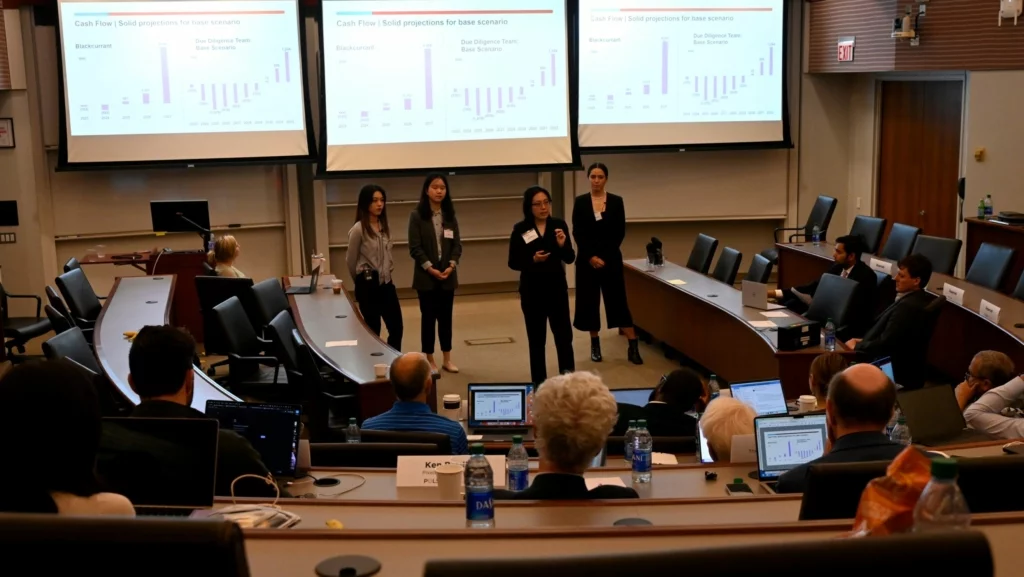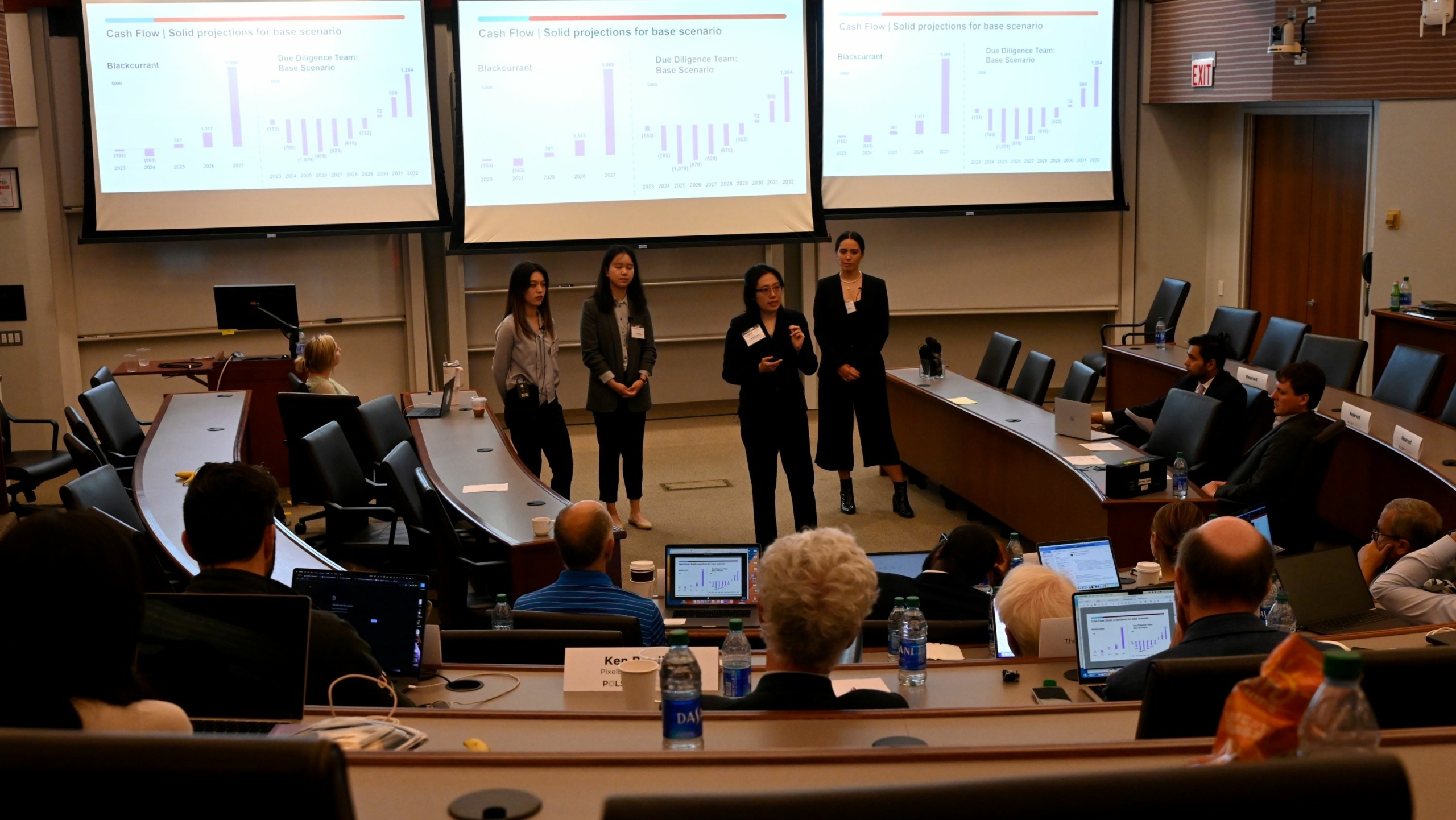Published on

The final three teams will pitch to the Innovation Fund Advisory Committee, which consists of advisors, entrepreneurs, and industry experts, as pictured here at the 2022 event.
Researchers have developed a proprietary machine learning approach, multi-tissue human organoid model, and a targeted drug delivery method – and will be seeking investment at the fall 2023 George Shultz Innovation Fund Finals.
Managed by the Polsky Center for Entrepreneurship and Innovation, the George Shultz Innovation Fund provides up to $250,000 in co-investment funding for early-stage tech ventures coming out of the University of Chicago, Argonne National Laboratory, Fermilab, and the Marine Biological Laboratory.
Register for the George Shultz Innovation Fund Finals >>
During the process, teams received guidance and dedicated support from the Polsky Center, business experts, an advisory committee, and student Innovation Fund Associates who are training in venture capitalism.
“We were very impressed with the applicants this cycle and are excited to move forward with the three finalists who are developing novel solutions to pressing problems in the life sciences and tech space,” said Omkar Bhave, director of investment strategy at the Polsky Center.
To date, the Innovation Fund has invested over $9 million in more than 90 companies that have gone on to raise more than $412 million in follow-on funding. Companies launched with the fund’s support include Onchilles Pharma, ExplORer Surgical, ClostraBio, Esya Labs, and Super.Tech.
The fall 2023 George Shultz Innovation Fund Finalists include:
// NetMicroscope is disrupting network performance monitoring with state-of-the-art machine learning-driven approaches. The solution integrates network performance metrics from a variety of data sources and integrates these to provide intelligence to network operators concerning the performance of specific applications in the network.
Team:
The team has developed and deployed custom, proprietary machine learning models trained to infer application and network performance problems and assist operators in rapidly remedying problems with model-driven diagnostics, thus improving overall user experience.
NetMicroscop also has monitoring software to collect statistics from network traffic. The tool is complementary, running on top of existing infrastructure to enhance the collected information from network traffic. The tool integrates fast anonymization of traffic for privacy and fast transformations to create features useful as input to machine learning models via passive and active measurements.
The solution is vendor-independent and fine-grained, providing more detailed information about which applications are not working and why, helping network operators to intervene before customer complaints arise.
// CellCipher has developed a process to apply single-cell RNA sequencing to embryoid bodies to study environmental and chemical exposures on human cells, thus generating population-scale data to enable drug discovery and personalized medicine.
Team:
- Yoav Gilad – cofounder, dean, biomedical and health informatics, University of Chicago
- Katherine Rhodes – cofounder, staff scientist in Yoav Gilad’s lab
- Jackson Finks – business development, Chicago Booth MBA student
The team has developed a multi-tissue human organoid (MTO) model that can be used to efficiently screen for drug toxicity and off-target effects in dozens of human cell types from tissues all throughout the body. MTOs are grown efficiently, in a single dish, and over a short period of time. Experiments to date have proven that the 68 cell types that comprise MTOs align well with known gene expression patterns in human embryonic stem cells, fetal cells, and adult human tissues, indicating that MTOs are a powerful model of human gene regulation.
When combined with single-cell RNA sequencing, CellCipher’s MTO system can be used to measure the transcriptional effects of candidate drugs in dozens of human cell types and across multiple individuals – all in a single, streamlined experiment. With its machine learning classifier trained on data from its MTO Drug Response Atlas, CellCipher will be able to provide clients with detailed toxicity profiles and predict off-target effects.
// INOFFA Therapeutics is developing a technology based on human bone marrow mesenchymal stem cells to restore the natural ovarian function for women with Primary Ovarian Insufficiency.
Team:
- Ayman Al-Hendy, cofounder, professor of obstetrics and gynecology, University of Chicago
The team is made up of several members of Al-Hendy’s lab, including fellow cofounder Mohammad M. Ghasroldasht, postdoctoral research scholar; Hiba Alkelani, a clinical research coordinator and the company’s chief medical officer, Farzana Begum Liakath Ali, postdoctoral research scholar and chief scientific officer, and Hang-Soo Park, a staff scientist.
INOFFA’s innovative solution uses exosomes—small vesicles secreted from umbilical cord stem cells—under novel conditions. These exosomes operate as targeted delivery agents, ferrying specialized cargo that includes miRNAs and proteins crucial for the rejuvenation of ovarian tissues.
The exosomes exhibit a distinctive nature, produced from umbilical cord stem cells under specific conditions meticulously formulated by INOFFA. This intricate engineering and development process ensures that these exosomes surpass mere carriers, embodying intricate vesicles meticulously designed for ovarian regeneration. The targeted approach helps minimize potential side effects and optimizes therapeutic impact, concentrating treatment where it is most efficacious.
About the George Shultz Innovation Fund
Managed by the Polsky Center for Entrepreneurship and Innovation, the George Shultz Innovation Fund provides up to $250,000 in co-investment funding for early-stage tech ventures coming out of the University of Chicago, Argonne National Laboratory, Fermilab, and the Marine Biological Laboratory. Learn more here.







